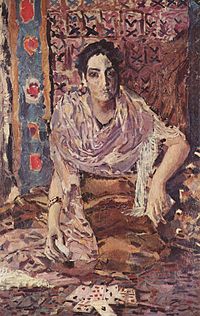
Back Kaartlêery Afrikaans Cartomància Catalan Kartářství Czech Kartenlegen German Cartomancia Spanish Kartomantia Estonian فال ورق Persian Cartomancie French Cartomanzia Italian カード占い Japanese
This article has multiple issues. Please help improve it or discuss these issues on the talk page. (Learn how and when to remove these template messages)
|


Cartomancy is fortune-telling or divination using a deck of cards.[1] Forms of cartomancy appeared soon after playing cards were introduced into Europe in the 14th century.[2] Practitioners of cartomancy are generally known as cartomancers, card readers, or simply readers.
Cartomancy using standard playing cards was the most popular form of providing fortune-telling card readings in the 18th, 19th, and 20th centuries. The standard 52-card deck is often augmented with jokers or even with the blank card found in many packaged decks. In France, the 32-card piquet stripped deck is most typically used in cartomantic readings, although the 52 card deck can also be used. (A piquet deck can be a 52-card deck with all of the 2s through the 6s removed. This leaves all of the 7s through the 10s, the face cards, and the aces.)
In English-speaking countries, the most common form of cartomancy is generally tarot card reading. Tarot cards are almost exclusively used for this purpose in these places.[3]
- ^ "In the Cards: A Brief History of Divination and Cartomancy". The Odyssey Online. 11 July 2016. Retrieved September 29, 2019.
- ^ Huson, Paul (2004). Mystical Origins of the Tarot: From Ancient Roots to Modern Usage. Vermont: Destiny Books. ISBN 0-89281-190-0
- ^ Knight, Jan (1980). A-Z of ghosts and supernatural. Pepper Press. pp. 15–6. ISBN 0-560-74509-5.
© MMXXIII Rich X Search. We shall prevail. All rights reserved. Rich X Search